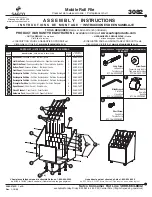
Mod-Demod
To ease the patching of modDemod effects, Signal 2 IN is normalled to Signal 1 OUT, thus connecting the two
circuits in series. Carrier/ CV 1 IN is normalled to Carrier CV 2 IN, so that in patching the desired Carrier Signal to
Carrier/ CV 2 IN, the modulation and demodulation processes share a single Carrier Signal. Patch Signal to be
processed to Signal 1 IN. Patch Carrier to Carrier/ CV 2 IN. Take output from Signal 2 OUT. The variation from circuit to
circuit will introduce demodulation errors that sound as distortions. Using the Strength controls, it is possible to
introduce more errors and to greatly reduce the integrity of the resulting signal. A nice variation on this patch uses a
pair of independent Carrier VCOs, which are tuned to same frequency, but not synced. Variations in waveshape and
Phase inaccuracies between the two VCOs will introduce more demodulation errors and distortions.
Octave UP
To ease the patching of octave UP effects. Carrier/ CV 2 IN is normalled to Signal 2 IN. Patch your signal to be
processed to Signal 2 IN. Patch the Signal 2 OUT into Signal 1 IN, take the output from SUM OUT. Use the Strength
controls to adjust timbre and blend of octaves.
DPO Supersaw
This patch uses voltage controlled inversion to derive a sawtooth wave from the DPO’s Final Output. Mixing it with
the VCOA Sawtooth produces a slightly unconventional, but nonetheless classic, supersaw.
Turn off all modulation to Final output parameters and the MOD BUS. Adjust FOLD panel control to ~9:00 so the
output is full amplitude but with no folds yet. Adjust ANGLE panel control to 12:00, listening for the fullest sound
available. Adjust SHAPE panel control full CW (100%) to “glitched triangle”.
DPO Final OUT -> ModDemix Ch1 Input
DPO Square -> ModDemix Ch1 Carrier/Mod Input
ModDemix Ch1 OUTput -> Mixer
DPO Sawtooth -> Mixer
Mix and detune the two sawtooths to taste. The sawtooth derived from the FINAL output will be one octave above
its original pitch, and it will also contain a slight “spike” at its peaks and troughs (because of its origins as a “glitched”
triangle, as well as varying slightly in amplitude every other period (because of the DC offset in the DPO’s square
wave). Combined with the unusual sawtooth shape on VCOA, which has a stronger-than-usual fundamental, this
patch produces a supersaw with character!
Summary of Contents for modDemix
Page 1: ...modDemix...


























